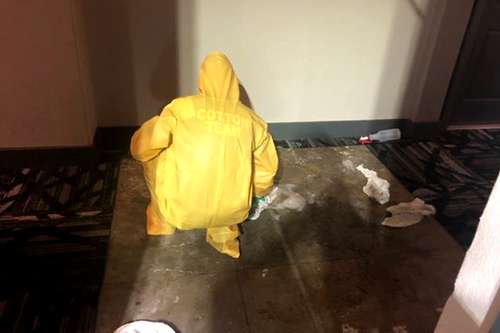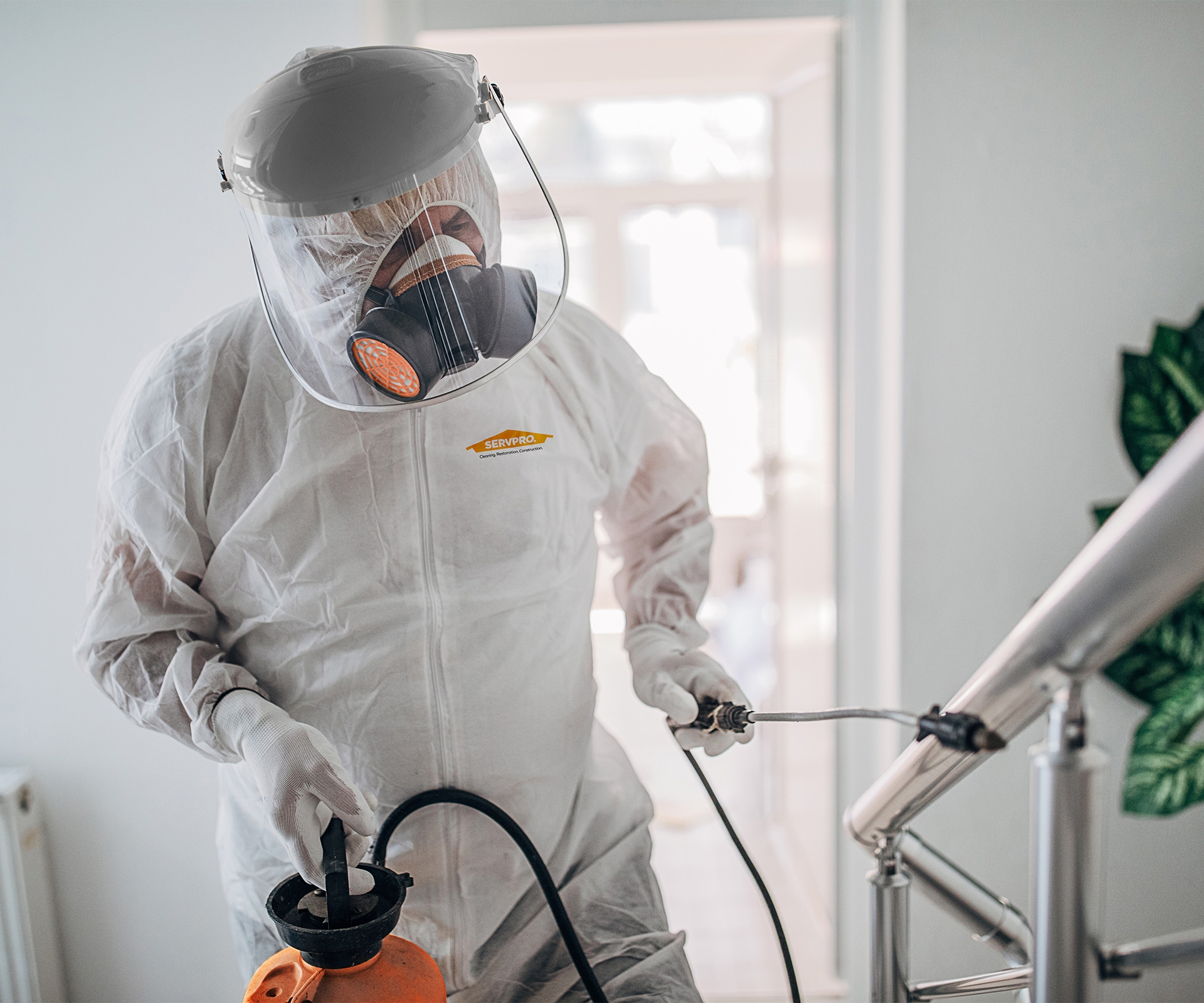Clandestine Lab Cleanup: Comprehensive Purification for Hazardous Sites
Clandestine Lab Cleanup: Comprehensive Purification for Hazardous Sites
Blog Article
Specialist Biohazard Cleaning and Decontamination for Blood, Bodily Fluids, and Hazardous Materials
The potential health and wellness risks connected with exposure to biohazards underscore the essential demand for thorough handling and comprehensive cleaning. As we navigate the intricate landscape of biohazard cleaning, recognizing the nuances of regulations, conformity, and the specialized devices at play comes to be imperative in making sure a secure and detailed purification process.
Wellness Threats of Biohazard Direct Exposure
Exposure to biohazards poses considerable health threats that can lead to extreme repercussions for communities and individuals alike. Biohazards include a large range of organic materials, including blood, bodily fluids, mold and mildew, germs, infections, and various other possibly infectious materials. When individuals enter call with these biohazards, whether via crashes, incorrect handling, or environmental direct exposure, they face the risk of having severe health problems or illness.
Among the key health and wellness risks connected with biohazard direct exposure is the transmission of transmittable illness. Bloodborne pathogens such as HIV, hepatitis B and C, and various microorganisms can be present in biohazardous products, posturing a straight threat to human health. Breathing in airborne biohazards like mold spores or entering call with infected surface areas can likewise result in breathing problems, allergies, and other damaging health and wellness impacts.
Additionally, biohazard exposure can have lasting wellness effects, with some illness showing up years after the first contact (Blood Cleanup). For that reason, it is vital to prioritize proper biohazard cleansing and decontamination to reduce these health and wellness risks and ensure the safety of individuals and neighborhoods

Specialized Educating for Biohazard Cleanup
When it concerns taking care of biohazard cleanup successfully and securely, specialized training plays an essential function in making certain appropriate decontamination treatments are complied with. Biohazard cleanup requires certain knowledge and skills to successfully minimize risks related to bloodborne microorganisms, physical fluids, and hazardous materials. Professionals learnt biohazard clean-up go through strenuous instruction on exactly how to safely deal with, remove, and dispose of biohazardous products to avoid contamination and direct exposure.
Specialized training for biohazard cleaning covers a variety of important subjects, consisting of proper individual protective tools (PPE) use, bloodborne microorganism awareness, decontamination methods, and dangerous waste disposal methods. Individuals educated in biohazard cleaning are outfitted with the essential knowledge to assess contamination degrees, recognize possible threats, and implement ideal clean-up treatments in conformity with governing criteria.
Continual training and education and learning are extremely important in the area of biohazard clean-up to remain upgraded on the current purification modern technologies, safety and security procedures, and laws. By purchasing specialized training, biohazard cleaning specialists can effectively respond to emergency cleaning situations and secure both public health and the environment.
Importance of Proper Purification Techniques
Using correct decontamination techniques is critical in biohazard clean-up to efficiently lessen and eliminate unsafe materials wellness risks. Effective purification not just ensures the removal of visible traces of blood, bodily fluids, and other biohazards but additionally targets unnoticeable pathogens that might position severe health and wellness hazards otherwise appropriately removed. By following stringent purification protocols, trained experts can considerably lower the threat of exposure to harmful bacteria, infections, and microorganisms that could bring about infections or diseases.
Proper decontamination techniques involve making use of specific devices and disinfectants that are specifically made to reduce the effects of biohazards properly. Extensive cleansing and sanitation of infected locations are vital to avoid the spread of pathogens and make certain a secure setting for passengers. In addition, the proper disposal of biohazardous waste following purification treatments is important in avoiding contamination of other surface areas or people.

Tools and Tools for Safe Cleaning
When dealing with blood, bodily liquids, or hazardous products, biohazard cleaning professionals depend on specialized gear to minimize direct exposure dangers and completely sanitize the affected location. Additionally, biohazard cleaning sets containing anti-bacterials, absorbent products, and biohazard bags are used to securely dispose and include of contaminated use this link items.
Advanced cleaning tools like hospital-grade anti-bacterials, HEPA-filtered vacuums, and fogging equipments are utilized to sterilize surface areas and eliminate biohazards efficiently. Specialized devices such as sharps containers and biohazard waste disposal containers are made use of to safely take care of sharp things and biohazardous waste products. By using the right tools and tools, biohazard cleansing professionals can make certain a comprehensive cleaning procedure that prioritizes safety and lessens wellness dangers for both workers and passengers of the afflicted room.
Laws and Compliance in Biohazard Cleansing
Proper adherence to regulations and conformity criteria is vital in biohazard cleansing to make sure the security of both employees and the atmosphere. Government firms such as OSHA (Occupational Safety and Wellness Management) and the EPA (Epa) have actually developed particular standards for biohazard cleanup treatments to minimize wellness threats and ecological contamination. These guidelines cover a variety of elements consisting of the handling, transport, and disposal of biohazardous materials, in addition to the required training and safety devices needed for personnel associated with the clean-up procedure.
Biohazard cleansing firms must stay up-to-date with these laws to assure that their operations fulfill the needed safety criteria. Failure to abide by these laws can result in severe repercussions, including penalties, lawsuit, and endangering the wellness of people and the environment. By following stringent laws and conformity measures, biohazard cleansing firms can successfully alleviate threats and guarantee a complete and risk-free cleanup procedure for all parties entailed.
Verdict
Finally, biohazard cleaning and decontamination need specific training, appropriate techniques, and adherence to regulations. Exposure to blood, bodily liquids, and dangerous products postures considerable wellness threats, making why not check here it critical to utilize the ideal equipment and tools for risk-free cleanup. By adhering to stringent protocols and guidelines, experts can efficiently mitigate the threats connected with biohazard exposure and make certain the safety of both themselves and others.
As we navigate the intricate landscape of biohazard cleanup, comprehending the nuances of policies, compliance, and the customized devices at play ends up being critical in guaranteeing a safe and comprehensive decontamination process. (Blood Cleanup)
When it comes to dealing with biohazard clean-up successfully and safely, specialized training plays an essential duty in making sure correct decontamination treatments are adhered to.Using proper purification strategies is essential in biohazard cleanup to properly reduce and eliminate unsafe products wellness risks. Additionally, biohazard cleaning packages having disinfectants, absorptive materials, and biohazard bags are utilized to safely dispose and have of contaminated things.
Federal government agencies such as OSHA (Occupational Security and Health Administration) and the EPA (Environmental Security Company) have actually try this out developed particular guidelines for biohazard cleaning procedures to lessen health and wellness dangers and environmental contamination.
Report this page